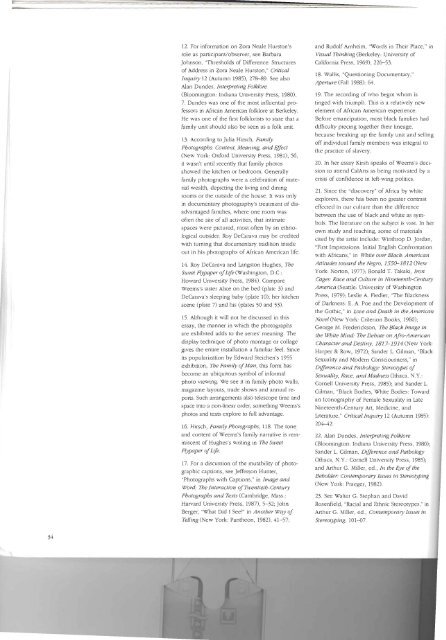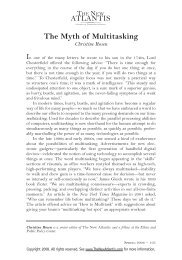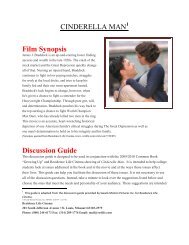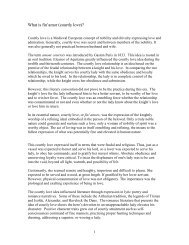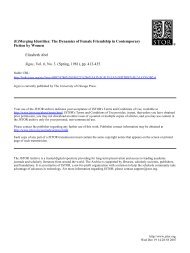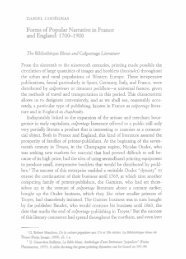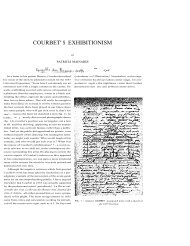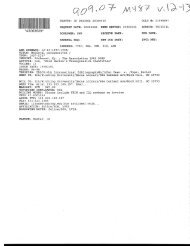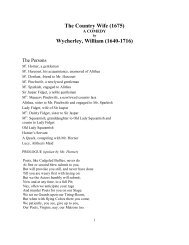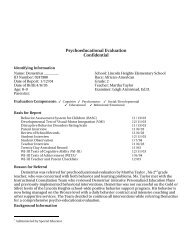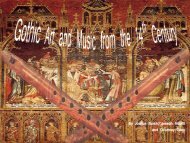CARRIE MAE WEEMS - People Search Directory
CARRIE MAE WEEMS - People Search Directory
CARRIE MAE WEEMS - People Search Directory
Create successful ePaper yourself
Turn your PDF publications into a flip-book with our unique Google optimized e-Paper software.
12. For information on Zora Neale Hurston's<br />
role as participant/observer, see Barbara<br />
johnson, "Thresholds of Difference: Structures<br />
of Address in Zora Neale Hurston," Critical<br />
Inquiry 12 (Autumn 1985), 278-89 See also<br />
Alan Dundes, Interpreting Folklore<br />
(Bloomington: Indiana University Press, 1980),<br />
7. Dundes was one of the most influential professors<br />
in African American folklore at Berkeley.<br />
He was one of the first folklorists to state that a<br />
family unit should also be seen as a folk unit.<br />
13. According to julia Hirsch, Family<br />
Photographs: Content, Meaning, and EjJect<br />
(New York: Oxford University Press, 1981), 56,<br />
it wasn't until recently that family pharos<br />
showed the kitchen or bedroom. Generally<br />
family photographs were a celebration of material<br />
wealth, depicting the living and dining<br />
rooms or the outside of the house. It was only<br />
in documentary photography's u'earment of disadvantaged<br />
families, where one room was<br />
often the site of a1l activities, that intimate<br />
spaces were pictured, most often by an ethnological<br />
outsider. Roy DeCarava may be credited<br />
with turning that documentary tradition inSide<br />
out in his photographs of African American life.<br />
14. Roy DeCarava and Langston Hughes, The<br />
Sweet Flypaper ofLife (Washington, D.c.:<br />
Howard University Press, 1984). Compare<br />
Weems's sister Alice on the bed (plate 3) and<br />
DeCarava's sleeping baby (plate 10); her kitchen<br />
scene (plate 7) and his (plates 50 and 53)<br />
15. Although it will nor be discussed in this<br />
essay, the manner in which the photographs<br />
are exhibited adds to the series' meaning. The<br />
display technique of photo montage or collage<br />
gives the entire insta1lation a familiar feel. Since<br />
its popularization by Edward Steichen's 1955<br />
exhibition, The Fami(y ofMan, this form has<br />
become an ubiquitous symbol of informal<br />
photo viewing. We see it in family photo wa1ls,<br />
magazine layouts, trade shows and annual reports.<br />
Such arrangements also telescope time and<br />
space into a non-linear order, sometl1ing Weems's<br />
photos and texts explore to full advantage.<br />
16. Hirsch, Family Photographs, 118. The tone<br />
and content of Weems's family narrative is reminiscent<br />
of Hughes's writing in The Sweet<br />
Flypaper ofLife.<br />
17. For a discussion of the mutability of photographic<br />
captions, see jefferson Hunter,<br />
"Photographs with Captions," in Image and<br />
Word: The Interaction of Twentieth-Century<br />
Photographs and Texts (Cambridge, Mass.:<br />
Harvard University Press, 1987), 5-32; john<br />
Berger, "What Did I See?" in Another Way of<br />
Telling (New York: Pantheon, 1982), 41-57;<br />
and Rudolf Arnheim, "Words in Their Place," in<br />
Visual Thinking (Berkeley University of<br />
California Press, 1969), 226-53.<br />
18. Wallis, "Questioning Documentary,"<br />
Aperture (Fa1l 1988): 64.<br />
19. The recording of who begot whom is<br />
tinged with triumph. This is a relatively new<br />
element of African American experience.<br />
Before emancipation, most black families had<br />
difficulty piecing together their lineage,<br />
because breaking up the family unit and selling<br />
off individual family members was integral to<br />
the practice of slavery.<br />
20. In her essay Kirsh speaks of Weems's decision<br />
to attend CatAns as being motivated by a<br />
crisis of confidence in left-Wing politiCS.<br />
21. Since the "discovery" of Africa by white<br />
explorers, there has been no greater contrast<br />
effected in our culture than the difference<br />
be[\veen the use of black and white as symbols.<br />
The literature on the subject is vast. In her<br />
own study and teaching, some of materials<br />
cited by the artist include: Winthrop D. jordan,<br />
"First Impressions: Initial English Confrontation<br />
with Africans," in White over Black: American<br />
Attitudes toward the Negro, 1550-1812 (New<br />
York: Norton, 1977); Ronald T. Takaki, Iron<br />
Cages: Race and Culture in Nineteenth-Century<br />
America (Seattle: University of Washington<br />
Press, 1979); Leslie A. Fiedler, "The Blackness<br />
of Darkness: E. A. Poe and the Development of<br />
the Gothic," in Love and Death in the American<br />
Novel (New York: Criterion Books, 1960);<br />
George M. Frederickson, The Black Image in<br />
the White Mind: 77Je Debate on Afro-American<br />
Character and Destiny, 1817-1914 (New York:<br />
Harper & Row, 1972); Sander L. Gilman, "Black<br />
Sexuality and Modern Consciousness," in<br />
Difference and Pathology: Stereotypes of<br />
Sexuality, Race, and Madness (Ithaca, N.Y.:<br />
Cornell University Press, 1985); and Sander L.<br />
Gilman, "Black Bodies, White Bodies: Toward<br />
an Iconography of Female Sexuality in Late<br />
Nineteenth-Century Art, Medicine, and<br />
Literature," Critical Inquiry 12 (Autumn 1985)<br />
204-42.<br />
22. Alan Dundes, Interpreting Folklore<br />
(Bloomington: Indiana University Press, 1980);<br />
Sander L. Gilman, Difference and Pathology<br />
(Ithaca, N.Y.: Cornell University Press, 1985);<br />
and Arthur G. Miller, ed., In the Eye ofthe<br />
Beholder.' Contemporary Issues in Stereotyping<br />
(New York: Praeger, 1982).<br />
23 See Walter G. Stephan and David<br />
Rosenfield, "Racial and Ethnic Stereotypes," in<br />
Althur G. Miller, ed., ContemporCilY Issues in<br />
Stereotyping, 101-07.<br />
34


